What is Doronicum and how to grow it?

The description of the doronicum flower shows its appeal to gardeners. But it is for this reason that it is important to become more familiar with its planting and care in the open field. The oriental perennial and other species of goat are worthy of attention; the process of reproduction of yellow chamomile seeds is also interesting.

Description
A huge number of flowering plants can be used in ornamental culture. However, among them, such a flower as doronicum occupies a worthy place, and is an excellent alternative to the more famous varieties. This, as is very often the case, is not a species, but a genus. This genus, according to the systematics generally accepted by biologists, is included in the Aster family, or otherwise Compositae, whose representatives are also:
-
cornflowers;
-
artichokes;
-
yarrow and elecampane;
-
chrysanthemums and cineraria;
-
chamomile;
-
daisies;
-
asters;
-
calendula and marigolds;
-
dahlias;
-
sunflowers and echinacea.


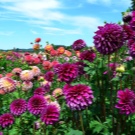



Doronicum is also called goat - this is no longer a botanical, but a purely domestic name. It has been established that this genus of plants predominantly populates areas of a temperate climate. In Eurasia, it rises in the mountains to an altitude of 3.5 km above sea level. One of the species is found in northern Africa, but this is an exception to the rule.

It has not yet been established how many types of doronicum exist, but there are at least 40 of them.... Since this plant looks very attractive and does not impose special requirements for cultivation, its popularity after its introduction into culture in the 16th century turned out to be very high. Doronicum, regardless of the specific species, is always a perennial. He noted the formation of basal and stem-covering foliage. The leaves themselves will be placed according to the next scheme. The fruit belongs to the category of achenes; it is oblong and has pronounced ribs.

Popular species and varieties
Austrian
The species received its name at a time when Austria had extensive possessions in the Mediterranean Sea. This plant is typical of the Mediterranean flora and gives straight stems.... Their upper parts are prone to branching. The total height reaches 70 cm. The Austrian doronicum was introduced into the culture as early as 1584.
Both stem and root leaves develop on the plant. The culture tolerates cold temperatures down to -30 degrees Celsius. If you prepare a good shelter and cover the goat with snow, it has every chance of surviving a more severe winter. In nature, this species grows in the Balkans. It is able to fit into any type of flower garden.

Altaic
Such doronicum grows in Siberia and Central Asia. Found its presence in the east of Kazakhstan and Mongolia. From a botanical point of view it is a common rhizome perennial growing up to 0.1-0.7 m. In such a goat, the stem is bare, it can be branched or devoid of branching, but it always includes thin ribs. Leafiness is not always present. The length of the peduncles reaches 30 cm, and inflorescences are formed on them, including from 1 to 4 yellow baskets.
The rhizome will be quite thick. Basal and part of the lower stem leaves may be reduced. All foliage is smooth and slightly pointed or blunt in shape. Flowering occurs from June to August inclusive. It should be noted that doronicum is sometimes also called yellow chamomile in everyday life.

Oriental
This perennial has a very well-developed rhizome. In the descriptions, attention is paid to the resilience to the effects of the shade. There are synonyms Caucasian and heart-shaped doronicum. In the wild, this species is found in Central Europe. And also it was recorded on the Mediterranean coast, in the Transcaucasia, in the Ciscaucasia and in the regions of Asia Minor.
Height reaches 0.5 m. Rhizome grows horizontally. Single baskets reach a cross section of 5 cm. The flowers are pale yellow or rich yellow, and are distinguished by a tubular structure. The cultural eastern doronicum has been known since 1808.

The optimal varieties are:
-
Spring Beauty (height up to 45 cm);
-
dwarf type Gold Dwarf (grows early, rises to 15 cm);
-
Little Leo (its bushes grow up to 35 cm).


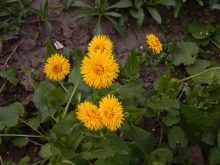
Columns
A feature of the species is an elongated tuberous root. The height of such a doronicum varies from 40 to 80 cm. Peduncles are practically bare. They develop heads with a cross section of up to 6 cm. The Gold Ostrich variety is distinguished, which blooms more abundantly than the base species.

Clusa
This goat is distinguished by a pronounced edging.... Its height is 10-30 cm. In nature, it lives in high-mountain meadows of the subalpine and alpine belts. Single baskets are yellow. The foliage is covered with characteristic hairs and is similar to the pointed end of a spear; peduncle densely pubescent.

Plantain
This species is found in the southwestern regions of Europe. It grows up to 140 cm and has oval-ovoid basal leaves. Yellow baskets with a section of 8-12 cm will open from the end of spring. Leaves die off at the end of June. The varieties Miss Mason and Excelsium are in demand.

Oblong
The rhizome of this doronicum is relatively short.... The stem is rather thick; closer to the apex, it is bare. Single pale yellow flowers are relatively small. The height of the plant varies from 12 to 50 cm. You can meet it in Siberia and Kazakhstan, in the mountains of the Caucasus and Central Asia.
There the oblong-leaved goat inhabits:
-
stony talus;
-
alpine and subalpine meadows;
-
banks of streams.
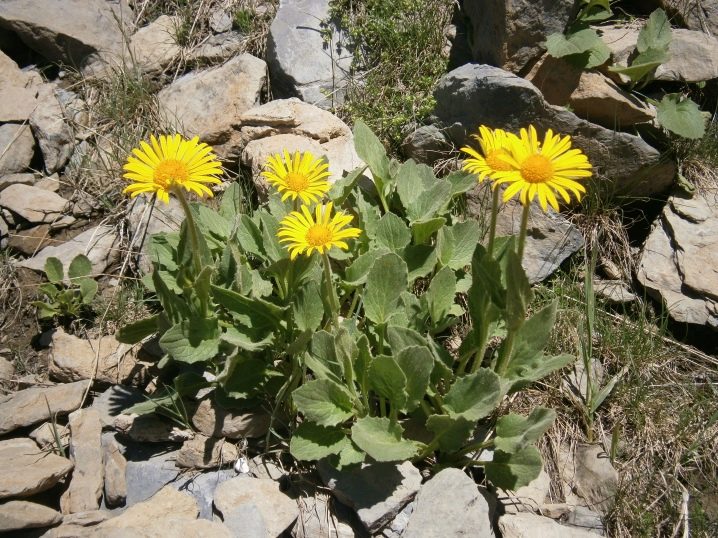
Teurkestan
The name itself suggests that such doronicum is found in Kazakhstan and Central Asia. However, it is also described in part of Siberia. Turkestan goat grows single stems, the lower third of which is covered with infrequent glandular hairs; these stems thicken strongly under the baskets. Leaves cover at least 50% of the stem. The formation of single baskets with a dark yellow core and light yellow reed flowers is characteristic.

Landing
The ability to plant doronicum is achieved only after warm weather has been firmly established. It is very important that the threat of frost disappears... Usually this situation develops at the very end of May or at the beginning of June. Seedlings should be hardened for 5-6 days before planting. They are kept outdoors daily, gradually increasing the habituation time.
It must be remembered that the doronicum is photophilous. He is able to survive during shading, but then you should not count on special decorativeness. The semi-shaded area allows the baskets to be as large as possible. To grow such a crop, it is necessary to avoid planting near trees, where it will experience difficulties.

Wet soil is unacceptable, but it must be sufficiently moist and loose.
The earth is dug up to 20-25 cm. Manure is certainly brought into it. We must not forget that after 2-3 years the bushes grow strongly, reaching a cross-section of about 0.5 m or more. Therefore, a gap between holes less than 0.4 m is not suitable. The depth and cross-section of the holes are selected in such a way that the seedling is placed in them together with the soil clod.

Care
Growing doronicum in the open field is up to even novice gardeners. This crop blooms twice for each growing season. The second time the buds appear in the middle of summer, and they persist until the end of August. In order for the bushes to remain decorative, after flowering, the arrow must be removed... The superficial root system of the doronicum requires active and frequent watering.

However, at the same time, stagnation of water in the ground, which can damage the bushes, is unacceptable. For irrigation, thoroughly settled water is used, heated in the sun during the day. Backfilling with mulch (wood shavings, wood chips or grass cuttings) is extremely helpful. This will keep the water in the ground for much longer. Under the mulch, the development of weeds is inhibited, the appearance of a crust is excluded.

With the onset of the vegetative period, doronicum must be fed necessarily... Along with liquid organic matter, a complex mineral mixture is sometimes used for this purpose. The same fertilizers are applied just before flowering. Plant rejuvenation is carried out at the very end of September or in the first 5-7 days of October. The division of the bush allows you to cope with the reduction in the size of the baskets and with the death of old stems.

Parts of a divided bush are planted in new areas in separate holes. Rejuvenation is carried out every 3-4 years, depending on the need... Especially large inflorescences are achieved with annual rejuvenation. Doronicum is not required for winter shelter in the usual regions.
Loosening and digging of the ground directly under the bushes is undesirable, due to the superficial placement of the roots.
Reproduction methods
Most often, seeds planted for seedlings are used to breed such a culture. This technique is especially reliable. Sowing is sometimes carried out directly into free land. This procedure is carried out in late autumn or May. It is necessary to start seedlings in April in a mesh tray.
A soil mixture is poured there, which is formed by equal proportions of peat and coarse sand. Each cell is sown with 2 or 3 seeds. Then the tray is covered with foil or glass. You need to keep it where bright, but diffused light falls. The crops are ventilated from time to time, removing condensate, and as the soil dries up, moistening the soil.
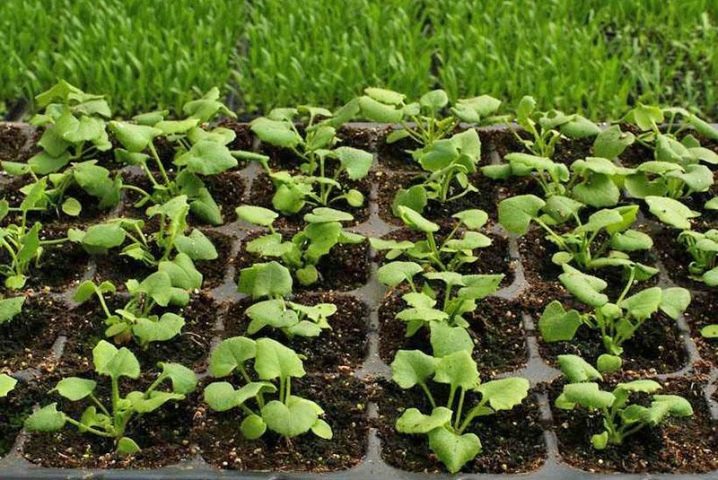
Under good conditions, doronicum gives early shoots. They will have to wait 10-14 days.... As soon as they arise, the shelter must be removed. Plants are rearranged in lighter places, continuing to protect them from direct sunlight.
In extremely poor natural light, the seedlings are illuminated using a fluorescent lamp or phytolamp; these light sources should be at a height of 20-25 cm.
It is undesirable to use conventional incandescent lamps. They are capable of overheating, in addition, the rays emitted by them can be harmful to the goat. Thinning of plantings is carried out as soon as they grow up to 4 cm. Only the strongest shoots are left in all cells.

Pinching after the appearance of 3-4 leaf plates helps to increase the splendor of the bushes.
Diseases and pests
Doronicum is often affected by aphids and thrips. They feed on the juices of the surface of the plant. Visually, this manifests itself in the appearance of yellow spots and stripes. The inflorescences soon become deformed and die off. The fight against such pests is by using karbofos, "Actellik" and other insecticides. Both Akarin and Agravertin will do.


Slugs are at particular risk. They actively feed on leaves. Sprinkle with ground pepper helps to prevent the attack of gastropods. Dry mustard powder is often used instead. Doronicum often suffers from rust, powdery mildew and gray mold.


Pathology appears mainly with poor care. And also these diseases can occur due to bad weather. A precisely matched irrigation regime helps to prevent fungal attack. It is necessary to carefully exclude both overdrying and stagnation of water.
Weed control is also an important support measure.
The appearance of bushes affected by gray rot is an alarming sign. Such plants are supposed to be dug up and burned as quickly as possible. For infection with rust and powdery mildew, solutions are usually used "Topaz" and Fundazola. Them, as well as the solution "Oxychoma" and other agents similar in action, must be applied in the spraying format 2, 3 or 4 times until the problem is solved. To reduce the risk of fungal infection, fresh manure should be avoided.



Application in landscape design
Often gardeners believe that doronicum in a flower bed will look too simple and faded. However, in reality, this is not the case. Such a plant invariably improves the landscape and improves the mood after the end of winter. In the garden, such a culture is usually a secondary decor. It is mainly used to create mixborders and rockeries.


Allowed to be used in the design of fences and cover unattractive outbuildings. Doronicum can also be used in ordinary flower beds. When planted in groups, this species is able to revive the composition. However, in the spring months, he is even able to dominate. Rogers, variegated hosts, and aquilegia are considered good companions; during flowering, compatibility with:
-
narcissist;
-
iris;
-
primrose;
-
tulip;
-
an ordinary nivyanik.



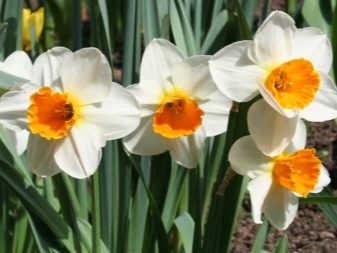
It is not necessary, however, to combine an exotic flower with just such crops. It can coexist well with forget-me-nots and brunner. Muscari will also make a great neighbor.



Doronicum of low-growing varieties are planted in containers. You just need to choose additional crops that will fill the voids as soon as the main species withers.







































































































The comment was sent successfully.